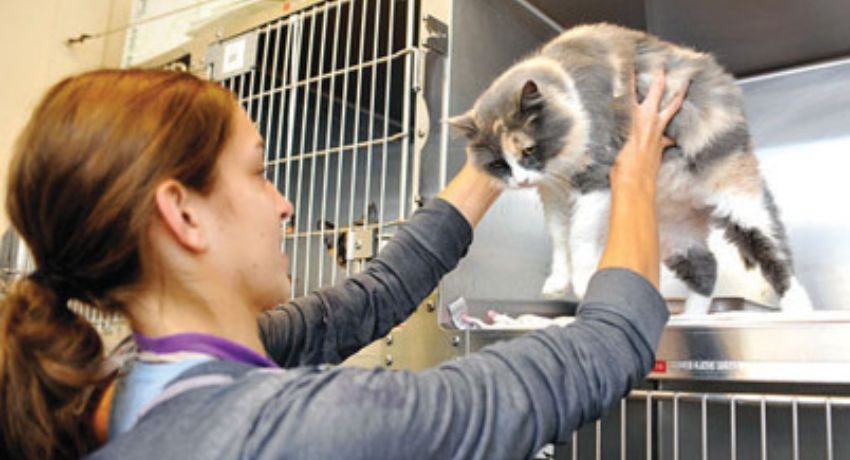Did you know a staggering 3.2 million cats enter shelters in the US each year, with only half finding their forever homes? That’s a lot of potential cuddle buddies missing out! But with over 3,500 brick-and-mortar shelters nationwide, you can easily adopt one.
What is more, we Americans love cats. Approximately 32 million households proudly share their lives with feline family members. Yet, despite this love, there are still countless cats in need of a forever home. Heartbreakingly, shelters euthanize around 530,000 cats annually.
But you can make a difference! One precious life can be saved by adopting a cat—especially a rescued one. Before you welcome a new feline friend, let’s explore essential tips for successful cat adoption.
Where to Look For Finding Rescue Cat

So, you’re ready to welcome a rescue cat into your life – fantastic! Now comes the fun part: finding your purrfect match. There are several resources you can explore.
- Local Animal Shelters: Start your search by visiting local animal shelters. These shelters often have a variety of cats available for adoption. You can meet the cats in person, learn about their personalities, and see which one tugs at your heartstrings.
- Rescue Organizations: Look for reputable rescue organizations in your area. These groups specialize in rescuing and rehoming animals. They often have foster homes where cats are cared for until they find their forever families.
- Breed-Specific Rescues: If you have a particular feline breed in mind, consider reaching out to breed-specific rescues like the Maine Coon Rescue. A simple search online or on social media platforms can lead you to these specialized organizations.
- Online Platforms: Explore online platforms such as Petfinder, Adopt-a-Pet, and Rescue Me. These websites aggregate listings from various shelters and rescue groups. You can search based on location, age, and other preferences.
- Cat Cafés: Experience a unique blend of coffee and companionship at cat cafés, where adoptable rescue cats roam freely. These innovative spaces offer a cozy atmosphere to connect with your potential feline friend.
- Social Media: Follow local animal rescue pages on social media platforms like Facebook and Instagram. Many shelters and volunteers post updates about available cats, adoption events, and success stories.
- Community Events: Attend adoption events, pet fairs, and community gatherings. These events often feature rescue cats looking for homes. It’s a great way to meet cats face-to-face and connect with fellow cat lovers.
Factors to Consider When It’s About ‘Choosing the Right Cat Companion’

Bringing home a cuddly companion is exciting, but before you get swept away in a sea of adorable meows, let’s see some factors to consider-
Balancing with Your Lifestyle
Living Situation:
- Apartment or House: Consider your living space. Cats can thrive in both apartments and houses, but some breeds may adapt better to smaller spaces.
- Outdoor Access: Do you have outdoor space for your cat to explore, or will they be strictly indoors?
Household Dynamics:
- Children: If you have kids, choose a cat with a friendly and patient temperament.
- Other Pets: Consider how the new cat will interact with existing pets (dogs, other cats, etc.).
- Allergies: Check if anyone in your household has cat allergies.
Financial Commitment:
- Food and Supplies: Cats need quality food, litter, toys, scratching posts, and regular vet visits. Budget accordingly.
- Vet Care: Factor in routine vaccinations, spaying/neutering, and unexpected medical expenses.
Time Commitment:
- Feeding and Cleaning: Cats require daily feeding, litter box maintenance, and grooming.
- Playtime and Interaction: Cats thrive on social interaction. Allocate time for play, cuddles, and bonding.
- Future Plan: Consider your future plans. Are you planning a move across the country? Will tiny humans be joining your family soon? Cats are a long-term commitment (think 12-18 years!), so ensure your lifestyle can accommodate a feline friend.
It’s All About Cat
Personality:
- Playful: Some cats love chasing toys and climbing. Others prefer lounging. Consider your energy level and match it with the cat’s personality.
- Shy or Outgoing: Are you looking for a social butterfly or a more reserved companion?
- Energetic vs. Laid-Back: Some cats zoom around like mini tornadoes, while others enjoy leisurely naps.
Age:
- Kitten: Kittens are adorable and playful but require patience and training.
- Adult: Adult cats often come with established personalities. They’re a great choice if you want to skip the kitten phase.
- Senior: Senior cats are wise and loving. Adopting one can be incredibly rewarding.
Health:
- Pre-existing Conditions: Some cats may have health issues. Be prepared for potential medical needs.
- Regular Check-Ups: Regular vet visits are crucial for maintaining your cat’s health.
Coat Length:
- Short-Haired: Low-maintenance and less shedding.
- Long-Haired: Requires regular grooming to prevent matting.
Bonus Tip: Don’t underestimate the power of a meet-and-greet! Spending time with potential feline companions at a shelter can help you find the purrfect personality match for your unique home.
Preparing Your Home for Your New Cat: Cat-Proofing 101
So you’ve found your purrfect match – congratulations! Now it’s time to transform your abode into a feline paradise. Here’s how to create a cat-tastic welcome:
A. Must-Have Supplies
- Food and water bowls: Choose sturdy, non-tip bowls for your cat’s meals. Place them in a quiet area away from their litter box.
- Litter box and litter: Invest in a good-quality litter box. Cats prefer privacy, so find a quiet corner for it. Use unscented, clumping litter. Scoop it daily to keep things fresh.
- Comfortable bed: Cats love cozy spots! Provide a soft bed or blanket where they can nap undisturbed.
- Tag collar or Microchipping: Safety first! Attach an ID tag with your contact information to your cat’s collar. Consider microchipping—a tiny chip under the skin that helps identify your cat if they get lost.
- Scratching post or pad: Cats need to scratch—it’s natural! Offer a scratching post, pad, or lounge to save your furniture. Place it near their favorite hangout spots.
- Cat carrier: Essential for vet visits and travel. Get a sturdy carrier with good ventilation.
- Toys: Keep your cat entertained with toys! Feather wands, laser pointers, and crinkly balls are favorites.
B. Creating a Safe Space
- Cat-proofing your home: Secure electric loose cords or hide them. Cats love to chew on them! Also, don’t forget to remove any toxic plants (like lilies) from your cat’s reach. If there are any kind of chemicals and cleaning supplies. store them safely. You know how curious explorer cats are!
- Providing hiding spots: Cats adore cardboard boxes. Leave a few around—they’ll become instant hideouts. Invest in a cat tree or shelves where your cat can climb and survey their kingdom.
- Setting up a designated feeding and litter box area: Choose a quiet spot for food and water. Cats like routine, so keep it consistent. Additionally, place the litter box away from their food and water. Privacy matters!
Bringing Your Cat Home and the Adjustment Period
You’ve prepped your pad, gathered the supplies, and your heart’s overflowing with excitement! Now comes the grand meow-ment: bringing your new feline friend home. Here’s how to navigate those first few crucial days:
1. The First Day
- Using a cat carrier for transport: When picking up your cat, use a secure cat carrier. It provides safety and prevents escape during the journey home. Line the carrier with a soft blanket or towel for comfort.
- Letting your cat explore their new space gradually: Once home, place the carrier in a quiet room. Open the door and allow your cat to come out at their own pace. Avoid overwhelming them with too much space initially.
- Offering food, water, and a litter box: Set up a designated feeding area with fresh water and high-quality cat food. Introduce your cat to the litter box. Show them where it is and let them explore.
2. Helping Your Cat Adjust
- Providing positive reinforcement: Reward good behavior with treats and gentle praise. This positive reinforcement helps your cat associate you with happy feelings.
- Offering playtime and interaction: Schedule playtime sessions to engage your cat’s natural hunting instincts and strengthen your bond. A feathery wand or a catnip-filled toy will do the trick! Spend time sitting quietly near your cat. Let them approach you when they’re ready.
- Being patient and understanding during the adjustment period: Remember, adjusting to a new environment takes time. Some may hide initially; others may explore boldly. Be patient with your cat’s anxieties and allow them to come out of their shell at their own pace.
3. Ongoing Care
- Regular feeding and litter box scooping: Establish a regular feeding schedule, litter box scooping routine, and playtime sessions to create a sense of security.
- Grooming needs: Depending on the breed, regular brushing and nail trimming might be necessary. These grooming sessions can be a wonderful way to bond with your cat. You can use Virbac C.E.T. Enzymatic toothpaste (certified vet recommended) for brushing your cat’s teeth. Also, use Safari self-cleaning slicker brush for regular cat grooming.
- Enrichment activities: Keep your cat mentally stimulated with climbing structures, scratching posts, and a variety of toys. A bored kitty can become a mischievous kitty!
- Litter box training: Accidents happen, especially during the adjustment period. Be patient with litter box training and use positive reinforcement when your cat uses it correctly.
- Build Trust: Let your cat approach you on their own terms, which is suggest by Dr. Adam Behrens, owner of Wandering Vet and member of the American Association of Feline Practitioners (AAFP). Gentle petting and soft voices go a long way in building trust and creating a lasting bond.
4. Introduce to Other Cats
If you have other furry (or feathery) family members, introduce them slowly and in a controlled environment. Keep initial interactions short. Supervise their interactions to ensure a smooth and harmonious transition. Allow them to sniff each other and observe body language.
5. Scheduling a Vet Appointment
Schedule an initial check-up with your veterinarian within the first week. This allows the vet to assess your cat’s overall health and administer any necessary vaccinations, deworming, and preventive care. Discuss any pre-existing medical conditions your cat may have.
6. Spaying/Neutering Your Cat
Spaying or neutering your cat is not only crucial for responsible pet ownership, but also helps prevent unwanted litters and certain health problems. If your cat isn’t already spayed or neutered, discuss this with your vet.
Enclosure
Adopting a rescue cat is an incredibly rewarding experience. You’ll be giving a deserving animal a loving home, and in return, you’ll gain a loyal companion who will bring endless joy and purrs into your life. So, visit your local shelter today and start your journey toward a purrfect friendship!

